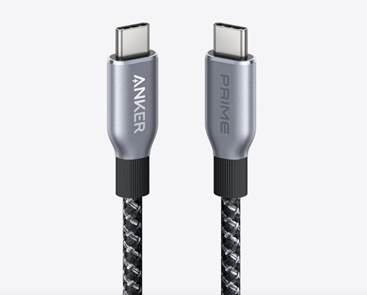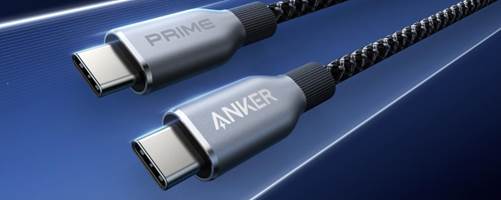The
demand for USB-C cables is growing as they become the standard for charging and
data transfer across various devices. While many cables look similar, their
internal components can differ significantly. It’s essential to prioritize
safety when selecting a USB-C cable because it impacts device performance and
longevity. This blog dives into the importance of choosing a safe USB-C cable,
key safety features to look for, and explains why the Anker Prime USB-C Cable
is an excellent choice for users focused on safety and durability.

Why Safety
Matters When Choosing a USB-C Cable
The Risks of
Using Low-Quality USB-C Cables
Low-quality
USB-C cables pose several risks, including overheating, short-circuiting, and
damaging your devices. Inferior materials and poor design contribute to these
dangers, leading to unreliable charging and data transfer. Additionally, they
might fail to meet industry safety standards, putting users at risk for
electrical hazards or fires. Investing in high-quality, certified cables
provides peace of mind and ensures the safe operation of your devices.
How
Overcharging and Heat Damage Occur
Overcharging
and heat damage typically occur when a USB-C cable lacks proper power
regulation and temperature control. Without these features, cables can deliver
inconsistent power levels, overheating, and potentially damage both the cable and the connected device. Over time,
this can degrade battery health and cause irreversible harm. Certified safety
features prevent such scenarios by regulating power flow and maintaining
optimal temperatures.
The Role of
Certified Safety Standards
Certified
safety standards, such as USB-IF certification, ensure that USB-C cables meet
rigorous industry benchmarks. These standards guarantee that cables provide
stable power delivery, efficient data transfer, and robust protection against
overheating. Adhering to these regulations ensures cables perform reliably
under various conditions and safeguard connected devices. Choosing USB-C cables
with recognized certifications is the best way to ensure safety and quality.
Key Safety
Features to Look for in USB-C Cables
Power Delivery
Control and Overcharge Protection
Power
delivery control is crucial for managing the energy flow between your device
and the power source. Look for cables with built-in overcharge protection to
prevent excessive power from damaging your devices’ batteries. These features
help maintain battery health and prolong the lifespan of your devices by
ensuring a stable and controlled power supply.
Temperature
Resistance and Heat Management
Effective
heat management is vital for preventing damage and ensuring safety. Temperature
resistance prevents cables from overheating during extended use. High-quality
USB-C cables often include advanced heat-dissipation mechanisms, keeping
temperatures within safe limits. This is essential for preserving the integrity
of both the cable and connected devices, enabling smooth operation regardless
of usage duration.
Durable
Materials and Cable Longevity
The
durability of a USB-C cable depends significantly on the materials used in its
construction. Cables made of high-grade materials resist wear and tear,
ensuring longevity and consistent performance. Features like braided exteriors
and reinforced connectors protect against physical damage and frequent bending,
minimizing the risk of internal breaks.
Why the Anker
Prime USB-C Cable Stands Out
240W
Ultra-Fast Charging with Smart Power Regulation
The
Anker Prime USB-C Cable offers unparalleled charging speed due to its 240W
power capacity. It can charge a 16-inch MacBook Pro up to 50% in just 26
minutes, making it a superb choice for users who require efficient power
delivery. Integrated smart power regulation ensures safe and stable charging,
optimizing energy flow to protect your devices and prevent overcharging.
Tested 300,000
Bends for Long-Term Durability
Anker
has rigorously tested the Prime USB-C Cable, demonstrating its ability to
withstand over 300,000 bends. This impressive durability ensures the cable
remains functional and intact for years, even with frequent use. Such
resilience minimizes the need for replacements, making it a reliable and
cost-effective choice for consumers seeking long-lasting cables.

Extreme
Temperature Adaptability and Sustainable Materials
The
Anker Prime USB-C Cable is engineered to operate efficiently under extreme
temperatures, from -40°F to 176°F. This adaptability guarantees your devices
stay powered in various environments. Additionally, the cable’s outer layer is
crafted from 100% post-consumer recycled materials, aligning with
sustainability goals.
How to Choose
the Best Safe USB-C Cable for Your Devices
To
select the best USB-C cable, consider cables with certified safety features,
such as power delivery and temperature control. Look for brands with a
reputation for quality and durability. Assess your needs, whether it’s fast
charging or long-term use. Prioritize cables made of robust materials and with
proven bend resistance. Reading reviews and choosing products with warranties
can also guide your decision, ensuring a reliable and safe investment for your
devices.
Conclusion
Choosing
the right USB-C cable is paramount to ensure the safety and efficiency of your
devices. Prioritizing cables with enhanced safety features, such as temperature
control and durable materials, protects your investment and offers peace of
mind. The Anker Prime USB-C Cable stands out with its impressive charging
speed, durability, and adaptability, making it a top choice among usb c cables. Make an
informed decision and benefit from reliable, safe, and efficient power delivery
for your devices.
